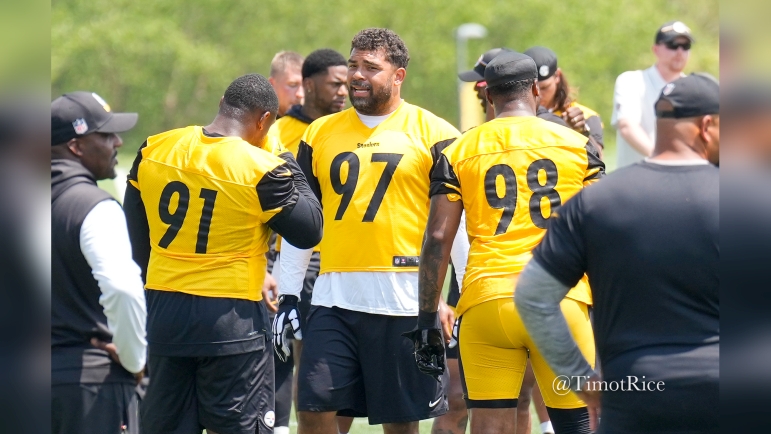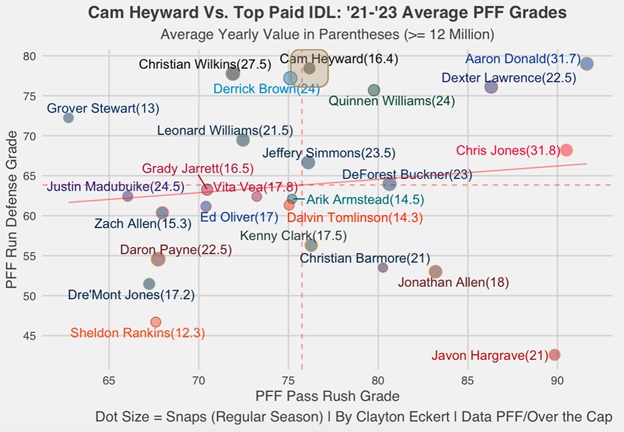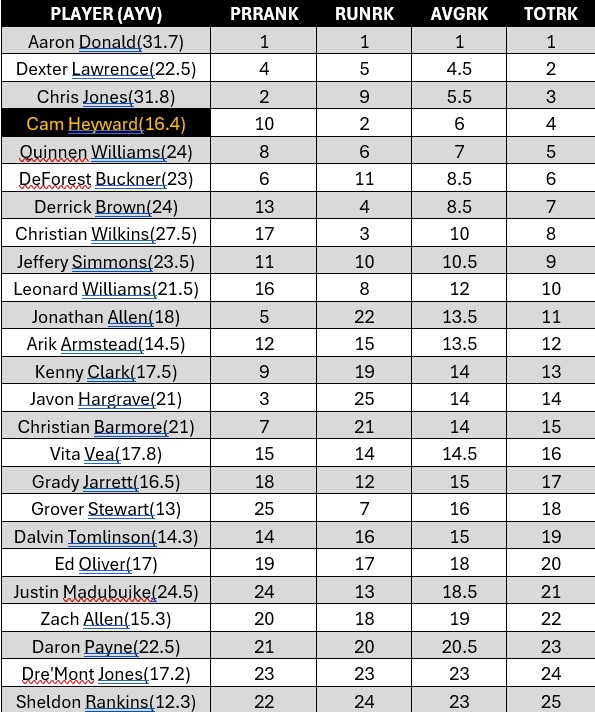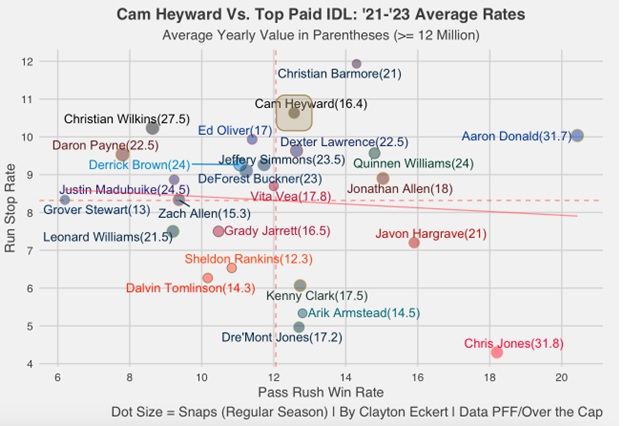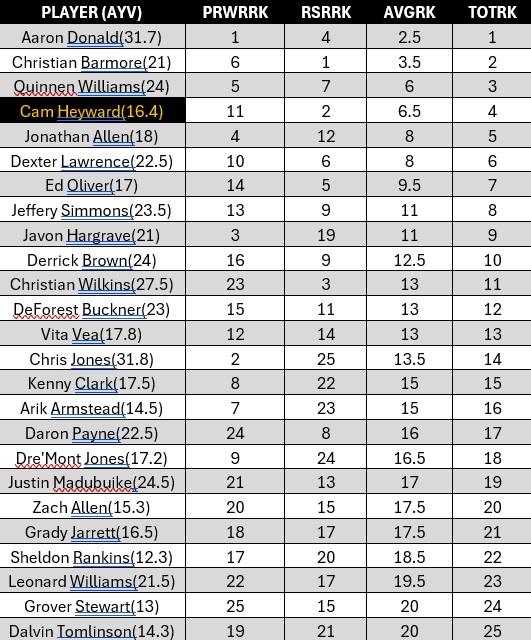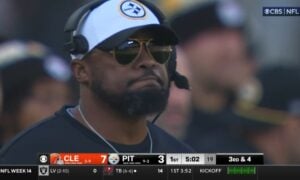Pittsburgh Steelers interior defensive lineman Cam Heyward has made it clear that he is looking for a contract extension. I usually refrain from these types of articles, considering our cap guru Dave Bryan covers the topic extremely well, including his thoughts on a possible Heyward contract extension that you should definitely check out.
My goal is to use a statistical approach to see how Heyward has performed the last three seasons compared to the top-paid players at the position via Over The Cap.
First, I wanted to see where Heyward stacked up among interior defensive linemen (IDL) at an average yearly value of $12 million or more in grades from Pro Football Focus, viewing their average pass-rush and run-defense grades the last three years along with total snaps over that span as their dot sizes:
Several familiar names land on the top right of the visual, with the best-balanced grades as pass rushers and run defenders, only seven out of the 25 qualifying IDL doing so. This includes Heyward, with an especially strong 78.4 run defense grade that ranked second since 2021. The only player to top Heyward in the span was Rams IDL Aaron Donald, barely (79.0).
Donald, the future Hall of Famer, swallowed much more cap space prior to retirement, with a 31.7 average yearly value. The second-highest number among IDL via Over The Cap is Chris Jones of the Chiefs (31.8). Both Donald and Jones top the pass-rush grades since 2021, the former coming in at 91.6, Jones at 90.5. Quality pass rushing gets you paid.
Heyward had a much lower (in comparison) 76.2 pass-rush grade, a respectably above-average 10th ranking among IDL in the time frame. Seeing Heyward’s $16.4 million average yearly contract value, the lowest number of players on the top right by a substantial amount (next least is 22.5), we get a sense of Heyward’s financial desires being understandable from a stats perspective.
A reasonable concern for the Steelers is age. Heyward is 35 years old, a historical number for IDL losing production. A case can be made that already occurred in 2023, though Heyward being hampered by injury hopefully was the primary reason as opposed to age.
For more context, here are Heyward’s grades and ranks by season among the 25 qualifiers:
2021: 85.8 pass-rush grade (fifth), 89.8 (second)
2022: 78.5 pass-rush grade (10th), 78.2 (fourth)
2023: 64.2 pass-rush grade (24th), 67.3 (10th)
Each grade trended down through the span, particularly as a pass rusher, with his 64.2 pass-rush grade in 2023 being second worst among his peers. It does make sense due to the injury he suffered in the season opener. It limited him to 11 games, and he clearly was fighting through it upon return.
Hopefully that was more of the issue than age and that Heyward can flip the script in 2024 to buck the IDL narrative at this stage of his career. The numbers do point to the pessimistic side of the coin though, with clear drop-offs in the data.
Going deeper, here is a ranking table of the grades from the first visual. These include pass-rush grades (PRRK) and run grades (RUNRK) and averaging the two (AVGRK), then using total snaps as a tiebreaker to get a final ranking (TOTRK) of the 25 qualifying players along with their average yearly values (AYV) in parenthesis:
This view paints Heyward in very favorable light, with a fourth TOTRK thanks to the aforementioned second RUNRK, and 10th PRRK. His $16.4 million AYV is the only one lower than $20 million in the top 10, so we get even more context to a new deal being fair to request from this standpoint.
The concerns I’ve outlined should keep a possible new deal south of $20 million per year, in my opinion, considering the average age of players in the top 10 TOTRK’s is 28. Two players have surpassed 30 years of age: Donald (33) and the Colts’ DeForest Buckner (30). By the start of the 2024 season, Jones and the Seahawks’ Leonard Williams will join that club as well.
The AYV for those four players is $27 million, but the age difference in regard to Heyward (35) really emphasizes that a deal of that magnitude is quite rare.
Next, I wanted to look at average rates over the three-year span in the same facets of the game, using pass-rush win rates and run-stop rates:
Very similar plot point for Heyward compared to the initial view. He ranked second once again in run defense, with a 10.6 run-stop rate. His 12.6 pass rush win-rate was slightly above average that landed at 11th. The players above the mean in both data points narrows by one to six, including Heyward, once again.
Here’s the year-to-year breakdown of the stats:
2021: 12.9 pass-rush win rate (11th), 8.6 run-stop rate (T-13th)
2022: 15.5 pass-rush win rate (fourth), 10.4 run-stop rate (fifth)
2023: 9.3 pass-rush win rate (19th), 12.9 run-stop rate (first)
These numbers show less of a dip in production than the grades indicate, particularly with noticeable improvements in run-stop rate each season. In fact, Heyward ranked first among qualifiers in run-stop rate last season, rather impressive considering the adverse year he had.
His best year in pass-rush win rate came in 2022, with a great 15.5 number that ranked fourth that season. Otherwise, he was outside the top 10, especially in 2023 with a rank of 19th (seventh-worst).
Less playing time is a factor too, so here are his snap totals by season:
2021: 955
2022: 801
2023: 442
The positive trend in run-stop rate is encouraging, providing more quality while the quantity lessened each year. Pass-rush win rates were trending that direction too prior to his injury-riddled 2023 campaign, which will hopefully be the case in 2024. Another piece of the puzzle to take into consideration.
Now, here is a similar ranking table as earlier, including pass-rush win rate (PRWRRK), run-stop rate (RSRRK), and averaging the two (AVRRK), then using the same tiebreaker of total snaps to get the final rank (TOTRK):
Once again, Heyward comes in at an impressive fourth TOTRK, which he also did in the initial grades. We also see that over the three-year span, Pittsburgh has gotten a great bang for their buck (16.4 AYV) given Heyward’s production. Two IDL snuck into the top 10 TOTRK’s with less than 20 million AYV’s (none in the grades view), Washington’s Jonathan Allen and Bills Ed Oliver.
When considering a possible contract extension for Heyward, the data really helps Heyward’s cause overall. While that is true, his statement of wanting to be in the top-five paid IDL would put him at a $24 million AYV, which seems high in my humble opinion.
The cons to a new deal are well-documented, such as age (oldest qualifying player by two years), recent injury, and some down trends in the three-year data. I personally think if a new deal gets done, an AYV around $17-19 million has been earned and would be a great gesture by Pittsburgh for the team captain prior to 2024.

